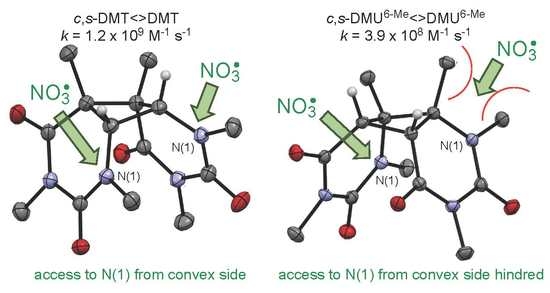Oxidative Repair of Pyrimidine Cyclobutane Dimers by Nitrate Radicals (NO3•): A Kinetic and Computational Study
Abstract
:1. Introduction
2. Materials and Methods
2.1. Synthesis of the Pyrimidine Cyclobutane Dimers
2.1.1. General
2.1.2. Synthesis of N-Methylated Pyrimidines
1,3-Dimethyluracil (DMU)
1,3-Dimethylthymine (DMT)
1,3.6-Trimethyluracil (DMU6-Me)
2.1.3. Dimerization of N-Methylated Pyrimidines
Synthesis of DMU<>DMU Isomers
- (a)
- t,a-DMU<>DMU: White crystals (0.35 g, 1.25 mmol, 3%, Rf = 0.26 (EtOAc)). 1H-NMR (400 MHz, CDCl3): δ 4.10 (dd, J = 9.4, 4.9 Hz, 2H), 3.53 (dd, J = 9.4, 4.9 Hz, 2H), 3.24 (s, 6H), 3.08 ppm (s, 6H). 13C {1H}-NMR (101 MHz, CDCl3): δ 167.1 (2C), 151.6 (2C), 53.7 (2C), 44.5 (2C), 33.8 (2C), 28.1 ppm (2C). HRMS (ESI) m/z calcd. for [C12H17N4O4]+: 281.1250 [M + H]+, found 281.1245.
- (b)
- t,s-DMU<>DMU: White crystals (1.12 g, 4.00 mmol, 8%, Rf = 0.18 (EtOAc)).1H-NMR (400 MHz, CDCl3): δ 3.87 (d, J = 8.0 Hz, 2H), 3.62 (d, J = 8.0 Hz, 2H), 3.25 (s, 6H), 3.06 ppm (s, 6H). 13C {1H}-NMR (101 MHz, CDCl3): δ 168.1 (2C), 151.8 (2C), 59.3 (2C), 39.1 (2C), 35.1 (2C), 28.3 ppm (2C). HRMS (ESI) m/z calcd. for [C12H17N4O4]+: 281.1250 [M + H]+, found 281.1245.
- (c)
- c,a-DMU<>DMU: White crystals (0.56 g, 2.00 mmol, 4%, Rf = 0.08 (EtOAc)). 1H-NMR (400 MHz, CDCl3): δ 4.09 (t, J = 8.5 Hz, 2H), 3.77 (t, J = 8.6 Hz, 2H), 3.12 (s, 6H), 3.11 ppm (s, 6H). 13C {1H}-NMR (101 MHz, CDCl3): δ 166.1 (2C), 152.2 (2C), 49.3 (2C), 45.4 (2C), 35.7 (2C), 27.8 ppm (2C). HRMS (ESI) m/z calcd. for [C12H17N4O4]+: 281.1250 [M + H]+, found 281.1245.
- (d)
- c,s-DMU<>DMU: White crystals (1.54 g, 5.49 mmol, 11%, Rf = 0.04 (EtOAc)). 1H-NMR (400 MHz, CDCl3): δ 4.06 (dd, J = 6.1, 3.9 Hz, 2H), 3.78 (dd, J = 6.1, 3.9 Hz, 2H), 3.16 (s, 6H), 3.00 ppm (s, 6H). 13C {1H}-NMR (101 MHz, CDCl3): δ 165.8 (2C), 152.8 (2C), 55.5 (2C), 39.6 (2C), 35.7 (2C), 28.0 ppm (2C). HRMS (ESI) m/z calcd. for [C12H17N4O4]+: 281.1250 [M + H]+, found 281.1245.
Synthesis of DMT<>DMT Isomers
- (a)
- c,a-DMT<>DMT: White crystals (0.70 g, 2.27 mmol, 7%, Rf = 0.04 (1:1 n-pentane/EtOAc)). 1H-NMR (400 MHz, CDCl3): δ 3.27 (s, 2H), 3.16 (s, 6H), 3.08 (s, 6H), 1.58 ppm (s, 6H). 13C {1H}-NMR (101 MHz, CDCl3): δ 169.6 (2C), 151.9 (2C), 64.4 (2C), 48.8 (2C), 36.3 (2C), 27.9 (2C), 25.0 ppm (2C). HRMS (ESI) m/z calcd. for [C14H21N4O4]+: 309.1563 [M + H]+, found 309.1557.
- (b)
- c,s-DMT<>DMT: White crystals (2.03 g, 6.58 mmol, 22%, Rf = 0.10 (EtOAc)). 1H-NMR (500 MHz, CDCl3): δ 3.72 (s, 2H), 3.14 (s, 6H), 3.00 (s, 6H), 1.50 ppm (s, 6H). 13C {1H}-NMR (126 MHz, CDCl3): δ 169.5 (2C), 152.5 (2C), 60.6 (2C), 47.6 (2C), 35.9 (2C), 28.3 (2C), 19.4 ppm (2C). HRMS (ESI) m/z calcd. for [C14H21N4O4]+: 309.1563 [M + H]+, found 309.1582.
Synthesis of DMU6-Me<>DMU6-Me Isomers
- (a)
- t,s-DMU6-Me<>DMU6-Me: White crystals (0.21 g, 0.67 mmol, 3%, Rf = 0.05 (1:1 n-pentane/EtOAc)). 1H-NMR (400 MHz, CDCl3): δ 3.27 (s, 6H), 3.23 (s, 2H), 3.00 (s, 6H), 1.42 ppm (s, 6H). 13C {1H}-NMR (101 MHz, CDCl3): δ 168.1 (2C), 152.4 (2C), 62.2 (2C), 45.1 (2C), 31.2 (2C), 28.5 (2C), 22.3 ppm (2C). HRMS (ESI) m/z calcd. for [C14H21N4O4]+: 309.1563 [M + H]+, found 309.1556.
- (b)
- c,a-DMU6-Me<>DMU6-Me: White crystals (4.11 g, 13.30 mmol, 53%, Rf = 0.19 (EtOAc)). 1H-NMR (400 MHz, CDCl3): δ 3.21 (s, 6H), 3.16 (s, 2H), 2.82 (s, 6H), 1.65 ppm (s, 6H). 13C {1H}-NMR (101 MHz, CDCl3): δ 165.3 (2C), 152.0 (2C), 58.0 (2C), 53.6 (2C), 31.2 (2C), 28.2 (2C), 27.8 ppm (2C). HRMS (ESI) m/z calcd. for [C14H21N4O4]+: 309.1563 [M + H]+, found 309.1557.
- (c)
- c,s-DMU6-Me<>DMU6-Me: White crystals (0.82 g, 2.67 mmol, 11%, Rf = 0.03 (2:1 n-pentane/EtOAc)). 1H-NMR (400 MHz, CDCl3): δ 3.41 (s, 2H), 3.16 (s, 6H), 2.92 (s, 6H), 1.52 ppm (s, 6H). 13C {1H}-NMR (101 MHz, CDCl3): δ 165.6 (2C), 152.8 (2C), 62.5 (2C), 44.9 (2C), 32.2 (2C), 28.0 (2C), 21.6 ppm (2C). HRMS (ESI) m/z calcd. for [C14H21N4O4]+: 309.1563 [M + H]+, found 309.1557.
2.2. X-ray Data
2.3. Laser Flash Photolysis Studies
2.4. DFT Calculations
3. Results
4. Discussion
5. Conclusions
Supplementary Materials
Author Contributions
Funding
Acknowledgments
Conflicts of Interest
References and Notes
- D’Orazio, J.; Jarrett, S.; Amaro-Ortiz, A.; Scott, T. UV Radiation and the Skin. Int. J. Mol. Sci. 2013, 14, 12222–12248. [Google Scholar] [CrossRef] [PubMed] [Green Version]
- Douki, T.; Sauvaigo, S.; Odin, F.; Cadet, J. Formation of the Main UV-induced Thymine Dimeric Lesions within Isolated and Cellular DNA as Measured by High Performance Liquid Chromatography-Tandem Mass Spectrometry. J. Biol. Chem. 2000, 275, 11678–11685. [Google Scholar] [CrossRef] [PubMed] [Green Version]
- Barak, Y.; Cohen-Fix, O.; Livneh, Z. Deamination of Cytosine-containing Pyrimidine Photodimers in UV-irradiated DNA. Significance for UV Light Mutagenesis. J. Biol. Chem. 1995, 270, 24174–24179. [Google Scholar] [CrossRef] [PubMed] [Green Version]
- Ravanat, J.-L.; Douki, T.; Cadet, J. Direct and indirect effects of UV radiation on DNA and its components. J. Photochem. Photobiol. B 2001, 63, 88–102. [Google Scholar] [CrossRef]
- Thomas, D.C.; Kunkel, T.A. Replication of UV-irradiated DNA in human cell extracts: Evidence for mutagenic bypass of pyrimidine dimers. Proc. Natl. Acad. Sci. USA 1993, 90, 7744–7748. [Google Scholar] [CrossRef] [PubMed] [Green Version]
- Burroughs, A.M.; Aravind, L. RNA damage in biological conflicts and the diversity of responding RNA repair systems. Nucleic Acids Res. 2016, 44, 8525–8555. [Google Scholar] [CrossRef] [Green Version]
- Krokan, H.E.; Standal, R.; Slupphaug, G. DNA glycosylases in the base excision repair of DNA. Biochem. J. 1997, 325, 1–16. [Google Scholar] [CrossRef]
- Brettel, K.; Byrdin, M. Reaction mechanisms of DNA photolyase. Curr. Opin. Struct. Biol. 2010, 20, 693–701. [Google Scholar] [CrossRef]
- Friedel, M.G.; Gierlich, J.; Carell, T. Cyclobutane Pyrimidine Dimers as UV-Induced DNA Lesions. In PATAI’S Chemistry of Functional Groups; Rappoport, Z., Ed.; John Wiley & Sons, Ltd.: Hoboken, NJ, USA, 2009. [Google Scholar] [CrossRef]
- Huntley, J.J.; Nieman, R.A.; Rose, S.D. Development and Investigation of a Novel Oxidative Pyrimidine Dimer Splitting Model. Photochem. Photobiol. 1999, 69, 1–7. [Google Scholar] [CrossRef]
- Treml, J.; Smejkal, K. Flavonoids as Potent Scavengers of Hydroxyl Radicals. Compr. Rev. Food Sci. F. 2016, 15, 720–738. [Google Scholar] [CrossRef]
- Heelis, P.; Deeble, D.; Kim, S.-T.; Sancar, A. Splitting of Cis-syn Cyclobutane Thymine-thymine Dimers by Radiolysis and Its Relevance to Enzymatic Photoreactivation. Int. J. Radiat. Biol. 1992, 62, 137–143. [Google Scholar] [CrossRef] [PubMed]
- Yan, L.-Q.; Song, Q.-H.; Hei, X.-M.; Guo, Q.-X.; Lin, W.-Z. Oxidative Splitting of a Pyrimidine Cyclobutane Dimer: A Pulse Radiolysis Study. Chin. J. Chem. 2003, 21, 16–19. [Google Scholar] [CrossRef]
- Alfassi, Z.B.; Harriman, A.; Huie, R.E.; Mosseri, S.; Neta, P. The redox potential of the azide/azidyl couple. J. Phys. Chem. 1987, 91, 2120–2122. [Google Scholar] [CrossRef]
- Ito, T.; Shinohara, H.; Hatta, H.; Nishimoto, S.-I.; Fujita, S.-I. Radiation-Induced and Photosensitized Splitting of C5−C5’-Linked Dihydrothymine Dimers: Product and Laser Flash Photolysis Studies on the Oxidative Splitting Mechanism. J. Phys. Chem. A 1999, 103, 8413–8420. [Google Scholar] [CrossRef]
- Baciocchi, E.; Del Giacco, T.; Murgia, S.M.; Sebastiani, G.V. Rate and mechanism for the reaction of the nitrate radical with aromatic and alkylaromatic compounds in acetonitrile. J. Chem. Soc. Chem. Commun. 1987, 1246–1248. [Google Scholar] [CrossRef]
- Krüger, O.; Wille, U. Oxidative Cleavage of a Cyclobutane Pyrimidine Dimer by Photochemically Generated Nitrate Radicals (NO3•). Org. Lett. 2001, 3, 1455–1458. [Google Scholar] [CrossRef]
- Boussicault, F.; Krüger, O.; Robert, M.; Wille, U. Dissociative electron transfer to and from pyrimidine cyclobutane dimers: An electrochemical study. Org. Biomol. Chem. 2004, 2, 2742–2750. [Google Scholar] [CrossRef]
- Neta, P.; Huie, R.E.; Ross, A.B. Rate Constants for Reactions of Inorganic Radicals in Aqueous Solution. J. Phys. Chem. Ref. Data 1988, 17, 1027–1284. [Google Scholar] [CrossRef]
- Wenska, G.; Paszyc, S. Electron-acceptor-sensitized splitting of cyclobutane-type thymine dimers. J. Photochem. Photobiol. B 1990, 8, 27–37. [Google Scholar] [CrossRef]
- Pac, C.; Kubo, J.; Majima, T.; Sakurai, H. Structure-reactivity relationships in redox-photosensitized splitting of pyrimidine dimers and unusual enhancing effect of molecular oxygen. Photochem. Photobiol. 1982, 36, 273–282. [Google Scholar] [CrossRef]
- Krüger, O. Oxidative Schädigung und Reparatur von Nucleobasen und Nucleosiden durch NO3 Radikale. Ph.D. Thesis, Christian-Albrechts University, Kiel, Germany, 2002. [Google Scholar]
- Sheldrick, G. SHELXT—Integrated space-group and crystal-structure determination. Acta Crystallogr. Sect. C 2015, 71, 3–8. [Google Scholar] [CrossRef] [PubMed] [Green Version]
- Macrae, C.F.; Bruno, I.J.; Chisholm, J.A.; Edlington, P.R.; McCabe, P.; Pidcock, E.; Rodriguez-Monge, L.; Taylor, R.; van de Streek, J.; Wood, P.A. Mercury CSD 2.0—New features for the visualization and investigation of crystal structures. J. Appl. Cryst. 2008, 41, 466–470. [Google Scholar] [CrossRef]
- Farrugia, L.J. WinGX suite for small-molecule single-crystal crystallography. J. Appl. Cryst. 1999, 32, 837–838. [Google Scholar] [CrossRef]
- Nathanael, J.G.; Hancock, A.N.; Wille, U. Reaction of Amino Acids, Di- and Tripeptides with the Environmental Oxidant NO3•: A Laser Flash Photolysis and Computational Study. Chem. Asian J. 2016, 11, 3188–3195. [Google Scholar] [CrossRef]
- Nathanael, J.G.; Gamon, L.F.; Cordes, M.; Rablen, P.R.; Bally, T.; Fromm, K.F.; Giese, B.; Wille, U. Amide Neighbouring-Group Effects in Peptides: Phenylalanine as Relay Amino Acid in Long-Distance Electron Transfer. ChemBioChem 2018, 19, 922–926. [Google Scholar] [CrossRef] [Green Version]
- Nathanael, J.G.; Wille, U. Oxidative Damage in Aliphatic Amino Acids and Di- and Tripeptides by the Environmental Free Radical Oxidant NO3•: The Role of the Amide Bond Revealed by Kinetic and Computational Studies. J. Org. Chem. 2019, 84, 3405–3418. [Google Scholar] [CrossRef]
- Del Giacco, T.; Baciocchi, E.; Steenken, S. One-Electron Oxidation of Alkylbenzenes in Acetonitrile by Photochemically Produced Nitrate Radical: Evidence for an Inner-Sphere Mechanism. J. Phys. Chem. 1993, 97, 5451–5456. [Google Scholar] [CrossRef]
- Frisch, M.J.; Trucks, G.W.; Schlegel, H.B.; Scuseria, G.E.; Robb, M.A.; Cheeseman, J.R.; Scalmani, G.; Barone, V.; Petersson, G.A.; Nakatsuji, H.; et al. Gaussian 16, Revision B.01; Gaussian, Inc.: Wallingford, CT, USA, 2016. [Google Scholar]
- Zhao, Y.; Truhlar, D.G. The M06 suite of density functionals for main group thermochemistry, thermochemical kinetics, noncovalent interactions, excited states, and transition elements: Two new functionals and systematic testing of four M06-class functionals and 12 other functionals. Theor. Chem. Acc. 2008, 120, 215–241. [Google Scholar] [CrossRef] [Green Version]
- Goerigk, L.; Hansen, A.; Bauer, C.; Ehrlich, S.; Najibi, A.; Grimme, S. A look at the density functional theory zoo with the advanced GMTKN55 database for general main group thermochemistry, kinetics and noncovalent interactions. Phys. Chem. Chem. Phys. 2017, 19, 32184–32215. [Google Scholar] [CrossRef] [Green Version]
- Goerigk, L.; Grimme, S. A thorough benchmark of density functional methods for general main group thermochemistry, kinetics, and noncovalent interactions. Phys. Chem. Chem. Phys. 2011, 13, 6670–6688. [Google Scholar] [CrossRef]
- Takano, Y.; Houk, K.N. Benchmarking the Conductor-like Polarizable Continuum Model (CPCM) for Aqueous Solvation Free Energies of Neutral and Ionic Organic Molecules. J. Chem. Theory Comput. 2005, 1, 70–77. [Google Scholar] [CrossRef] [PubMed]
- Nathanael, J.G.; White, J.M.; Richter, A.; Nuske, M.; Wille, U. Radical-induced oxidative damage of proline is influenced by its position in a peptide: A kinetic and product study. manuscript in preparation.
- Goeschen, C.; White, J.M.; Gable, R.W.; Wille, U. Oxidative Damage of Pyrimidine Nucleosides by the Environmental Free Radical Oxidant NO3• in the Absence and Presence of NO2• and Other Radical and Non-Radical Oxidants. Aust. J. Chem. 2012, 65, 427–437. [Google Scholar] [CrossRef]
- The higher reactivity of DMT and DMU6-Me could be due to the additional methyl group at C(5) and C(6), respectively, which should lower the redox potential compared with that of DMU.
- Quantum mechanical tunneling was not considered in the HAT calculations, as these were aimed to qualitatively assess the most reactive sites and not to predict rate coefficients for these processes. Experimental rate data have been determined previously (see ref. [35]).
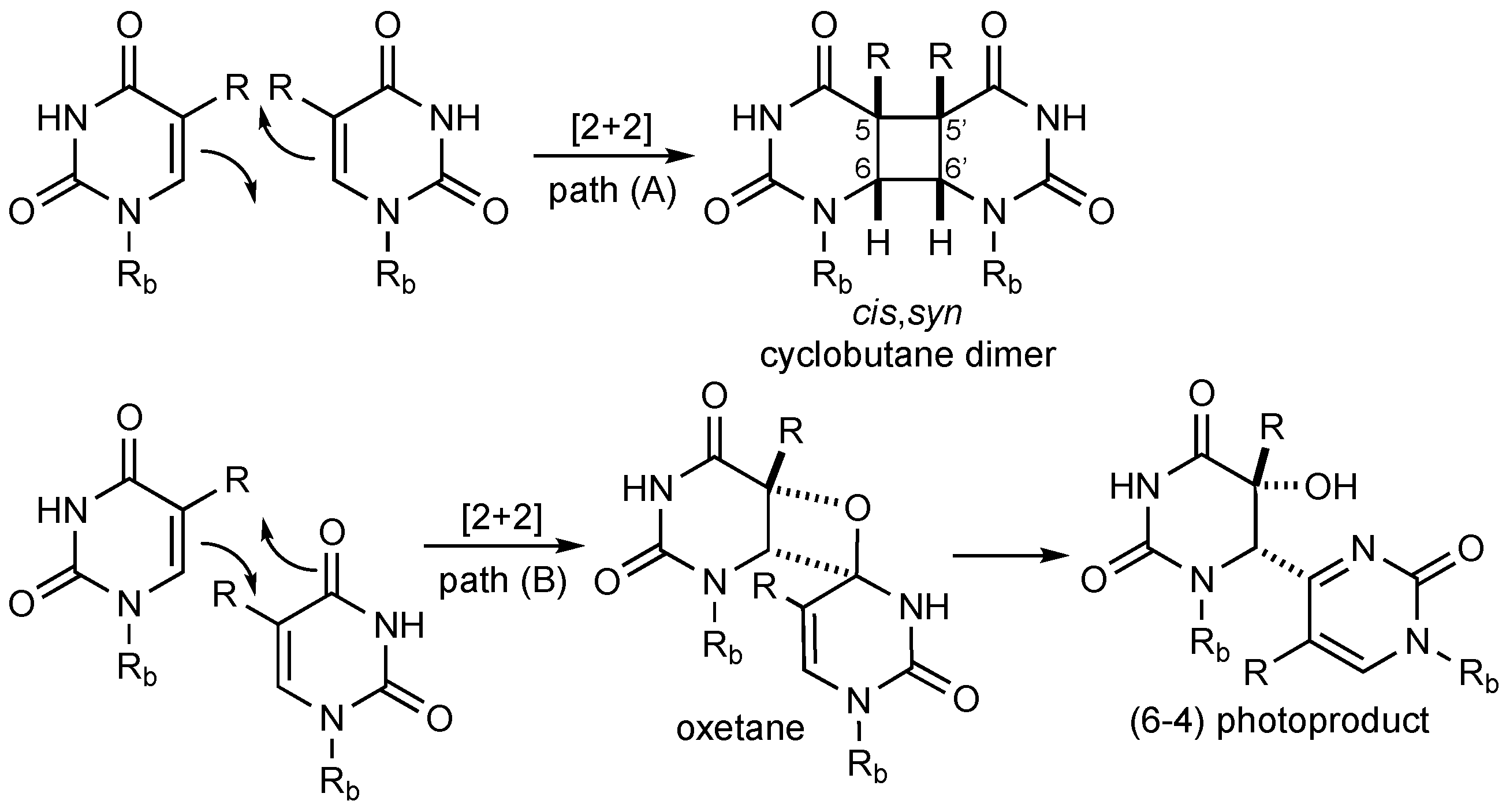
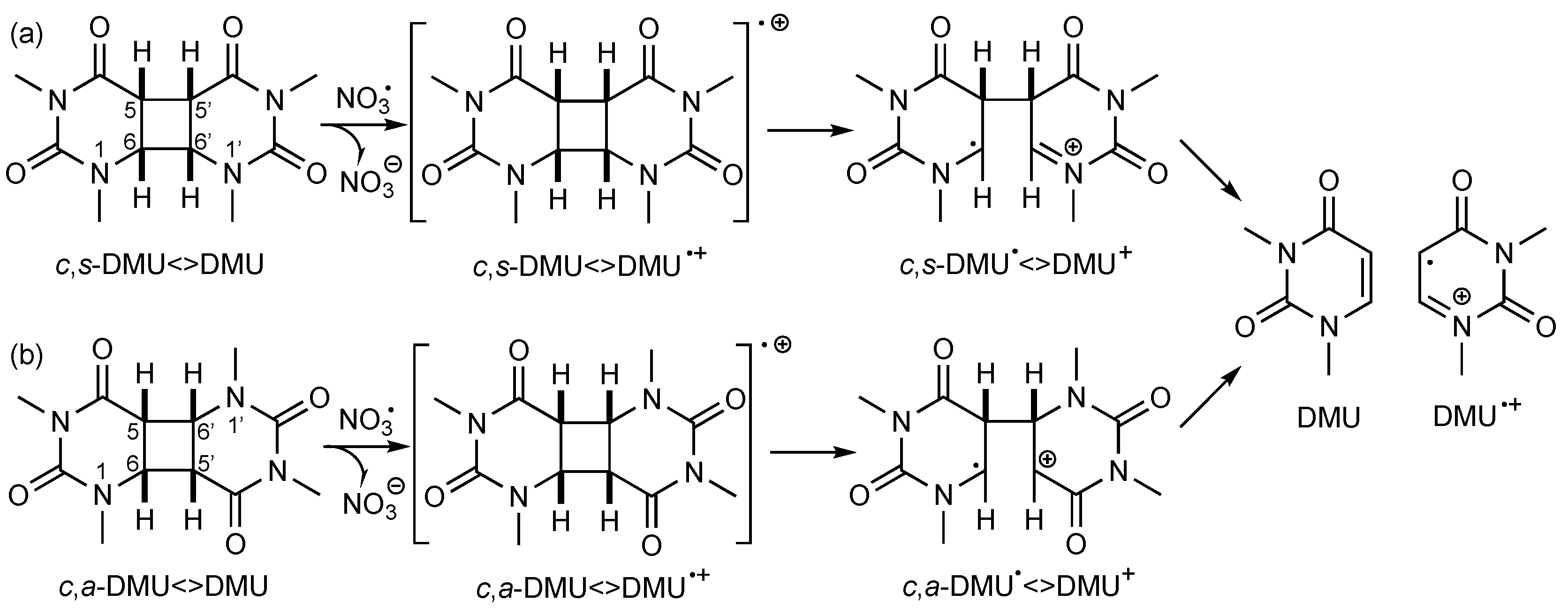
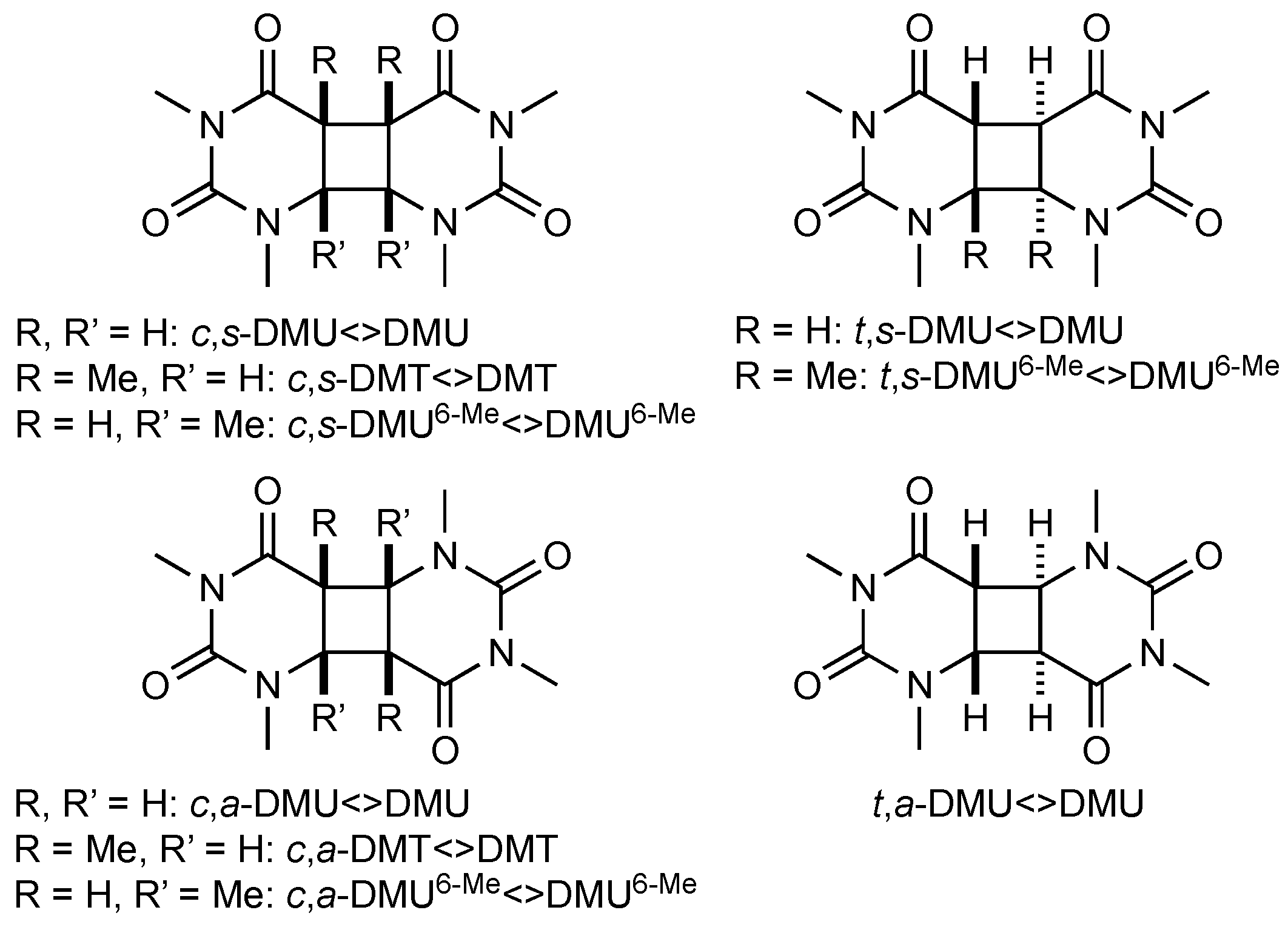
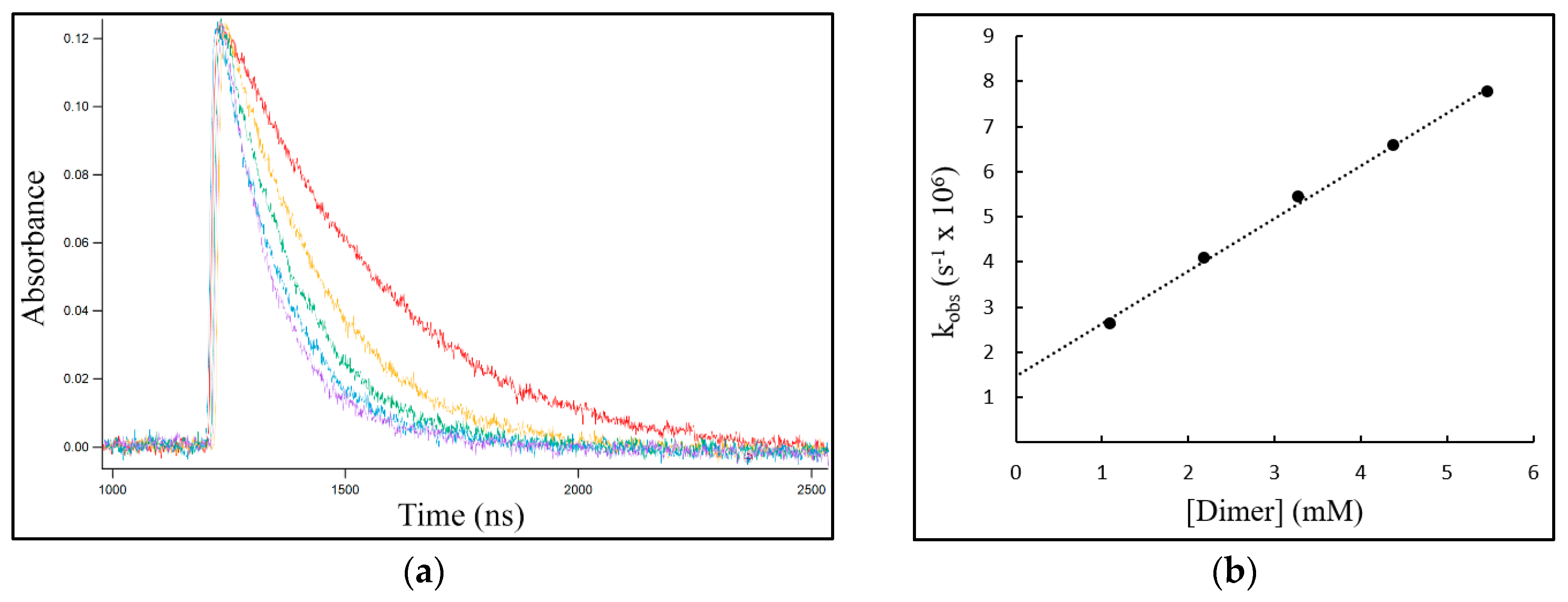
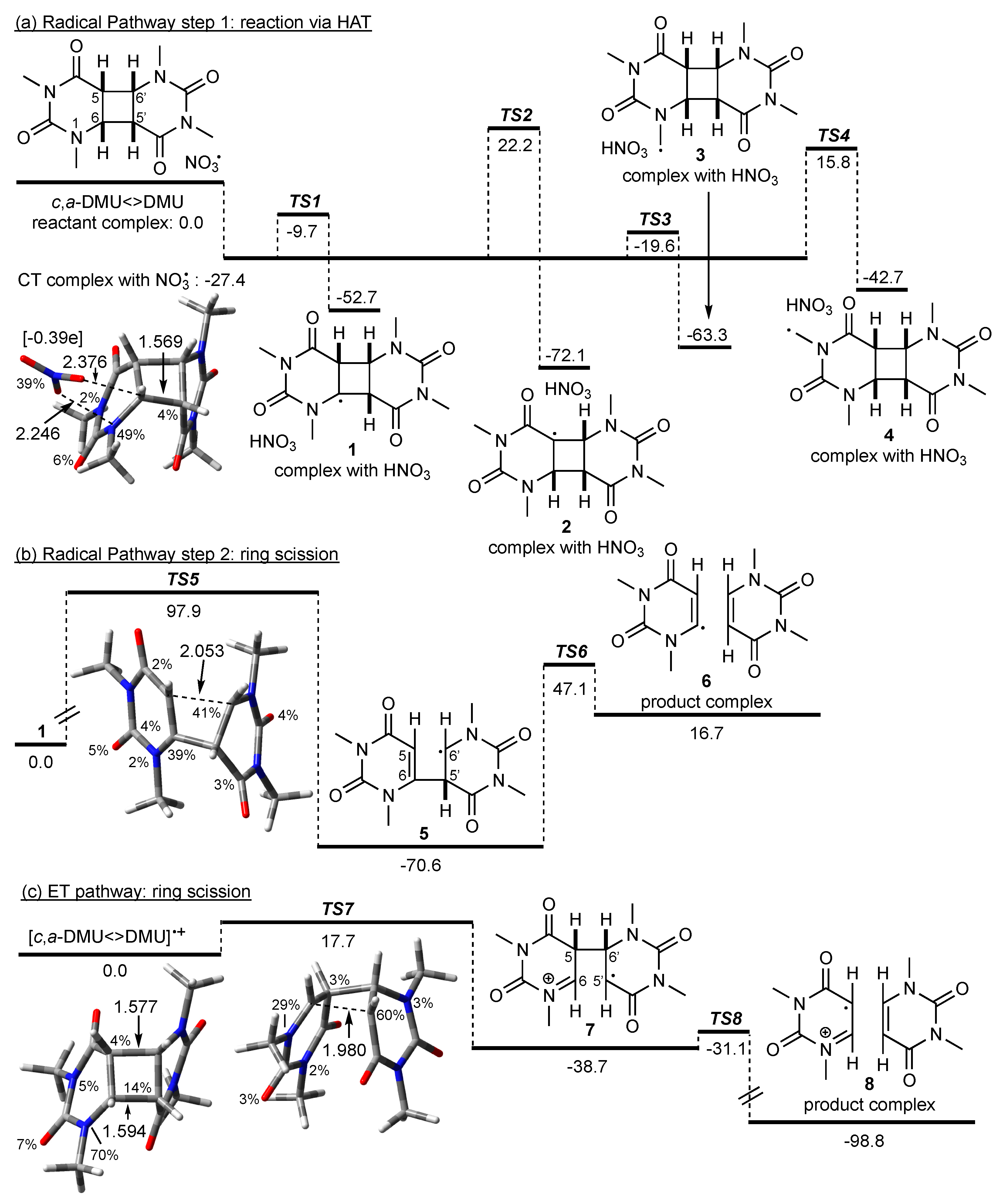
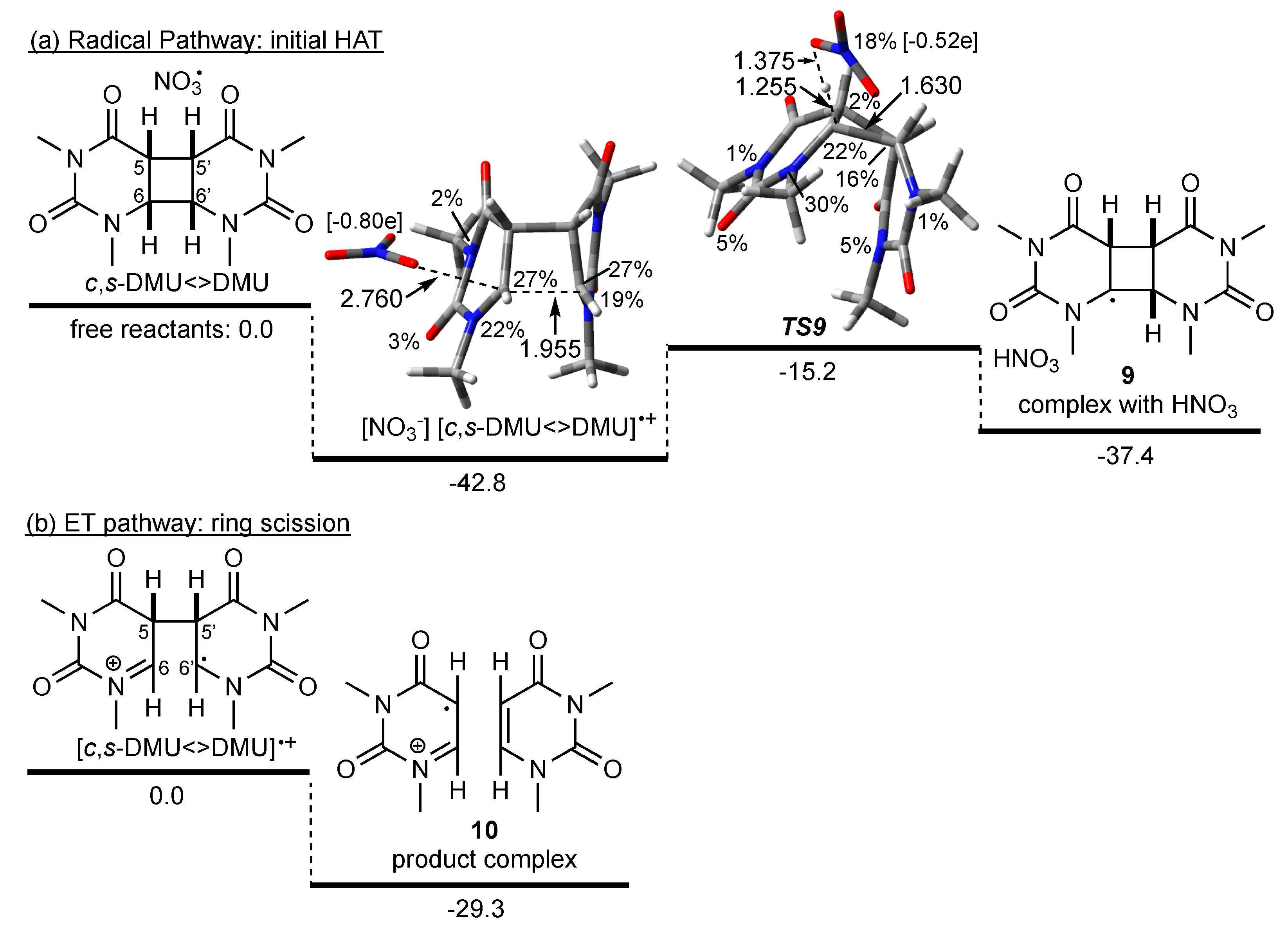
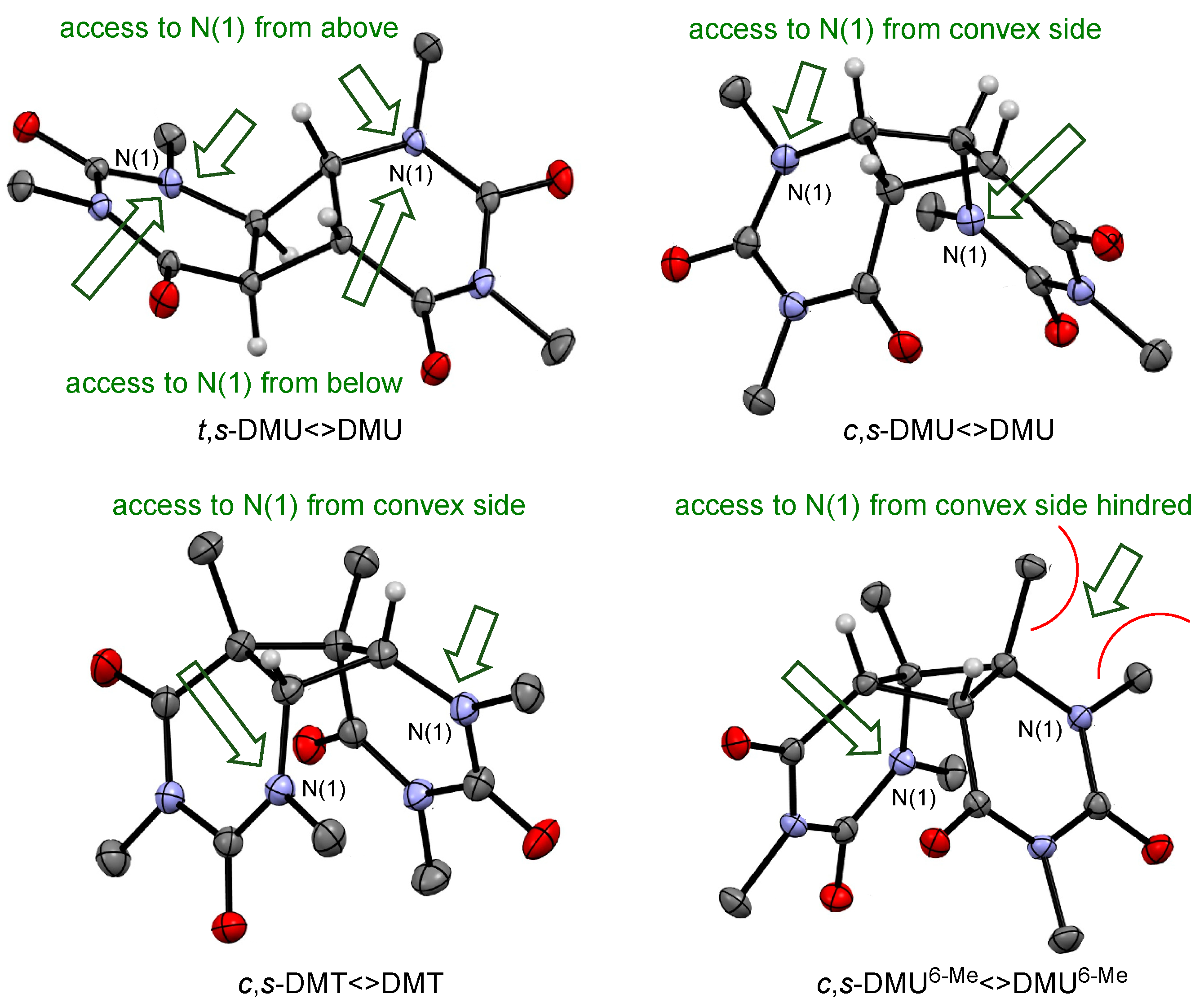
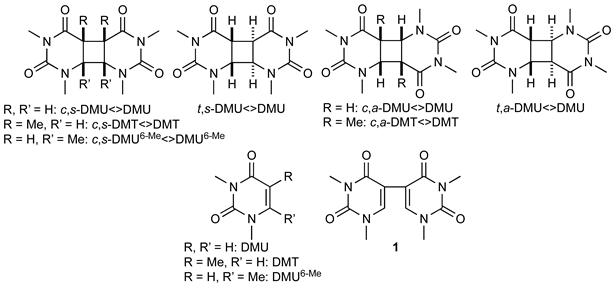
| Entry | Dimer(s) 1 | E0 2 | Products 3 |
| Product Studies 4 | |||
| 1 5 | c,s-DMU<>DMU | 1.825 | c,s-DMU<>DMU (7%), DMU (50%), 1 (33%) |
| 2 5 | t,s-DMU<>DMU | 1.850 | t,s-DMU<>DMU (37%), DMU (14%), 1 (35%) |
| 3 5 | c,a-DMU<>DMU | ≈2.195 | c,a-DMU<>DMU (39%), DMU (33%) |
| 4 5 | t,a-DMU<>DMU | t,a-DMU<>DMU (30%), DMU (34%) | |
| 5 | c,s-DMT<>DMT | 1.815 | c,s-DMT<>DMT (48%), DMT (48%) |
| 6 | c,a-DMT<>DMT | c,a-DMT<>DMT (58%), DMT (25%) | |
| 7 | c,s-DMU6-Me<>DMU6-Me | c,s-DMU6-Me<>DMU6-Me (22%), DMU6-Me (73%) | |
| Competition Studies 6 | |||
| 8 | c,s-DMU<>DMU + t,s-DMU<>DMU | c,s-DMU<>DMU (76%), t,s-DMU<>DMU (24%) | |
| 9 | c,a-DMU<>DMU + t,a-DMU<>DMU | c,a-DMU<>DMU (60%), t,a-DMU<>DMU (40%) | |
| 10 | c,s-DMT<>DMT + c,a-DMT<>DMT | c,s-DMT<>DMT (19%), c,a-DMT<>DMT (81%) | |
| 11 | c,s-DMU<>DMU + c,s-DMT<>DMT | c,s-DMU<>DMU (29%), c,s-DMT<>DMT (71%) | |
| 12 | c,s-DMU<>DMU + c,s- DMU6-Me<>DMU6-Me | c,s-DMU<>DMU (8%), c,s- DMU6-Me<>DMU6-Me (92%) | |
| 13 | c,s-DMT<>DMT + c,s- DMU6-Me<>DMU6-Me | c,s-DMT<>DMT (31%), c,s- DMU6-Me<>DMU6-Me (69%) | |
| Entry | Dimer | k/M−1 s−1 | Monomer: k/M−1 s−1 |
|---|---|---|---|
| 1 | t,s-DMU<>DMU | 2.8 × 109 | DMU: 1.0 × 109 |
| 2 | c,s-DMU<>DMU | 9.0 × 108 | |
| 3 | t,a-DMU<>DMU | 5.5 × 108 | |
| 4 | c,a-DMU<>DMU | 3.1 × 108 | |
| 5 | c,s-DMT<>DMT | 1.2 × 109 | DMT: 6.3 × 109 |
| 6 | c,a-DMT<>DMT | 5.2 × 108 | |
| 7 | t,s-DMU6-Me<>DMU6-Me | 5.7 × 108 | DMU6-Me: 4.8 × 109 |
| 8 | c,s-DMU6-Me<>DMU6-Me | 3.9 × 108 | |
| 9 | c,a-DMU6-Me<>DMU6-Me | 8.0 × 107 |
© 2020 by the authors. Licensee MDPI, Basel, Switzerland. This article is an open access article distributed under the terms and conditions of the Creative Commons Attribution (CC BY) license (http://creativecommons.org/licenses/by/4.0/).
Share and Cite
Haddad, T.; Nathanael, J.G.; White, J.M.; Wille, U. Oxidative Repair of Pyrimidine Cyclobutane Dimers by Nitrate Radicals (NO3•): A Kinetic and Computational Study. Chemistry 2020, 2, 453-469. https://doi.org/10.3390/chemistry2020027
Haddad T, Nathanael JG, White JM, Wille U. Oxidative Repair of Pyrimidine Cyclobutane Dimers by Nitrate Radicals (NO3•): A Kinetic and Computational Study. Chemistry. 2020; 2(2):453-469. https://doi.org/10.3390/chemistry2020027
Chicago/Turabian StyleHaddad, Tomas, Joses G. Nathanael, Jonathan M. White, and Uta Wille. 2020. "Oxidative Repair of Pyrimidine Cyclobutane Dimers by Nitrate Radicals (NO3•): A Kinetic and Computational Study" Chemistry 2, no. 2: 453-469. https://doi.org/10.3390/chemistry2020027
APA StyleHaddad, T., Nathanael, J. G., White, J. M., & Wille, U. (2020). Oxidative Repair of Pyrimidine Cyclobutane Dimers by Nitrate Radicals (NO3•): A Kinetic and Computational Study. Chemistry, 2(2), 453-469. https://doi.org/10.3390/chemistry2020027




